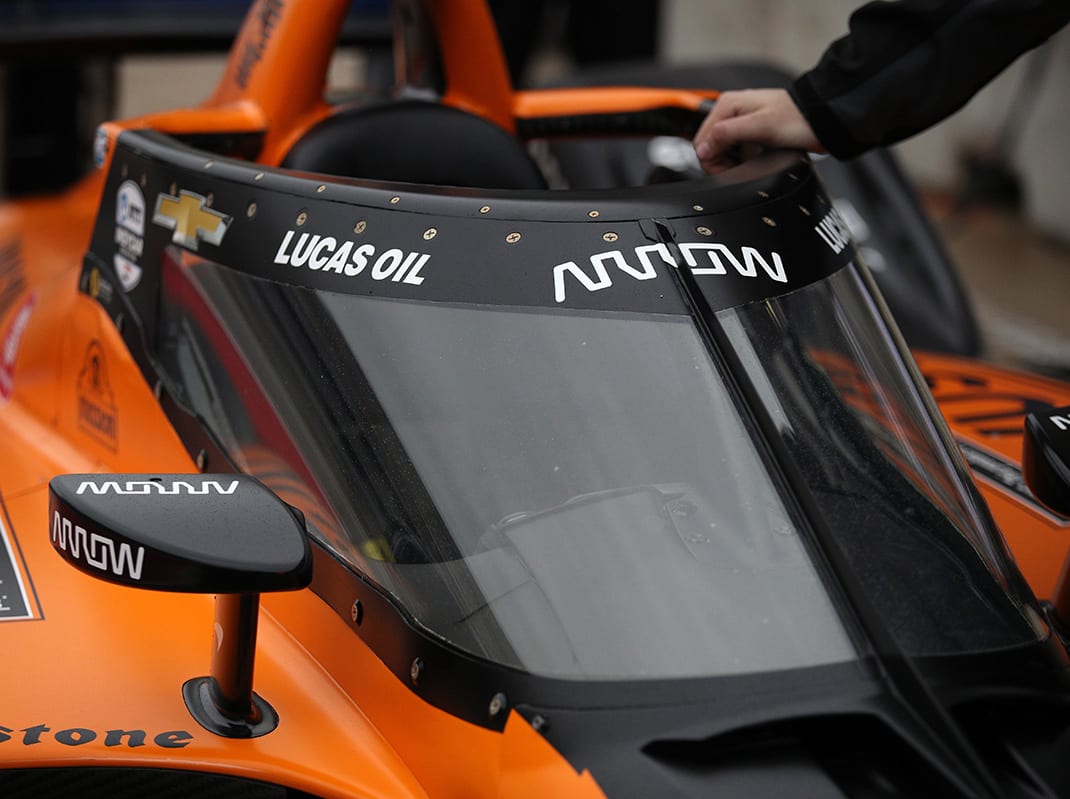MOORESVILLE, N.C. – To add to the intrigue of Saturday’s Genesys 300 NTT IndyCar Series contest at Texas Motor Speedway, the event will be the first race of the aeroscreen era.
The safety initiative features a partially enclosed canopy-style aeroscreen that is added for additional driver safety. Although various types of the aeroscreen have been tested for more than two years, Saturday’s race will be the first time it has been used at night.
Because the COVID-19 pandemic forced a lengthy shutdown to sports and regular life, the IndyCar Series banned all testing.
So, what challenges exist to use the aeroscreen at night in terms of glare and possible reflection?
“That’s a good question,” said IndyCar star Alexander Rossi of Andretti Autosport. “I think the bigger question mark that we all have is how the aeroscreen is going to play a factor in the heat. Obviously, Texas is a really hot race. It’s already pretty physically demanding just because of that fact.
“With the screen it’s going to be quite a bit hotter, so is it going to make that big of a difference or not. Again, we haven’t really tested so we don’t really know.
“Ultimately I think that’s the bigger question mark in terms of physical preparation versus the one-day event. We’ve done similar things in the past before, and ultimately everyone is very prepared. We’ve had a couple extra months now to make sure we’re ready to go come the first race. From that standpoint, I don’t think it’s too big of an issue. It’s, again, just the heat and having the mental capacity to go through all the processes that you’ll do in practice and qualifying and then still have enough bandwidth left come race time.”
Five-time NTT IndyCar Series champion Scott Dixon has been one of the main test drivers of the aeroscreen project for IndyCar. His feedback has been vital in the evolution and development of the safety device.

“I think it should be pretty good,” Dixon said. “I think with some of the testing that we had done even at Indianapolis, Richmond, then a bunch in the road course kind of platform, I think the unknowns we’ve never really run at night with the Aeroscreen. They moved the race starting time up by an hour so you’re going to have that transition from the light. It could be a bit of an issue.
“Honestly, some of those things we kind of witnessed a little bit of that at COTA when the practice session ended quite late. There were some pieces that you could kind of put on the screen to help with some of the reflection. That was better.”
Nearly every driver in the field has tested with the aeroscreen except one. Amazingly, it’s long-time star Tony Kanaan, who did not participate in the pre-season test at Circuit of the Americas in February. Kanaan is scheduled to compete in all five of the oval races on the schedule.
The only time he has had a chance to adapt to the visual aspect of the aeroscreen is through the iRacing IndyCar Challenge – a six-race virtual series that ran through May 2. He said he hopes his experience in the digital world will allow him to adapt to the aeroscreen in real life.
“Honestly I hope so because I have no idea how to answer that because I have not been in the car,” Kanaan said. “I didn’t even sit in the car in the shop. My car is not ready yet with the windscreen. I think I’m going to go to the shop tomorrow and try.
“iRacing has been, as far as the graphics, pretty good at it. Hopefully it will be the same. If it’s the same, I have plenty of sim time already.”
Nothing replaces the real thing and no matter how realistic iRacing and simulators are to helping drivers prepare for an event, the best tests and evaluations will come in a real race car on a real race track under high speeds.
“I think the one thing to take away from iRacing is it’s the first time that any of us saw the aeroscreen a stint into a virtual race or a real race,” said Andretti Autosport driver Zach Veach. “We ran the thing at COTA and there wasn’t really any bugs or debris there, so you didn’t get to see much, but at Sebring obviously there was some insects and stuff that would accumulate on it, but nothing that was bad to see through. But with the iRacing thing you actually got to see quite a bit of rubber on the aeroscreen itself, which I want to think is realistic. A lot of their models have been as far as like how the marbles build up outside of the racing line.
“As Alex said, I think we’re worried more so about what the heat is going to be like in Texas, just that first race back, trying to be a bit race fit. That usually comes in with the second or third race, so that’s going to be more of an adjustment, I think, than visually.
“But there is a slight worry of the sunset. That first stint at Texas is always so difficult because the sun isn’t behind the grandstands yet. But we’re just going to get creative with some tinted tear-offs and pull those as necessary just like we did in the last two years.”
Marco Andretti has competed in every race at Texas Motor Speedway since 2006. Glare is something drivers have had to contend with before the advent of the aeroscreen.
He believes teams and drivers will adapt.
“I’m not sure how realistic iRacing is from a glare standpoint, but I think with or without the wind screen, the first stint is always tough at Texas with the sun,” Andretti said.
